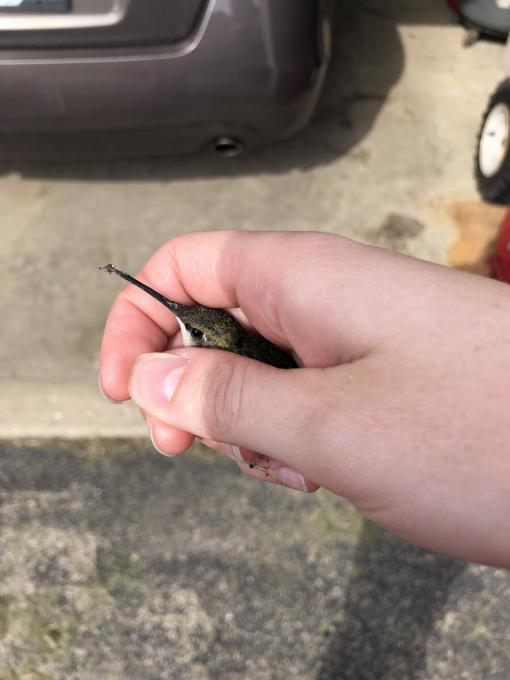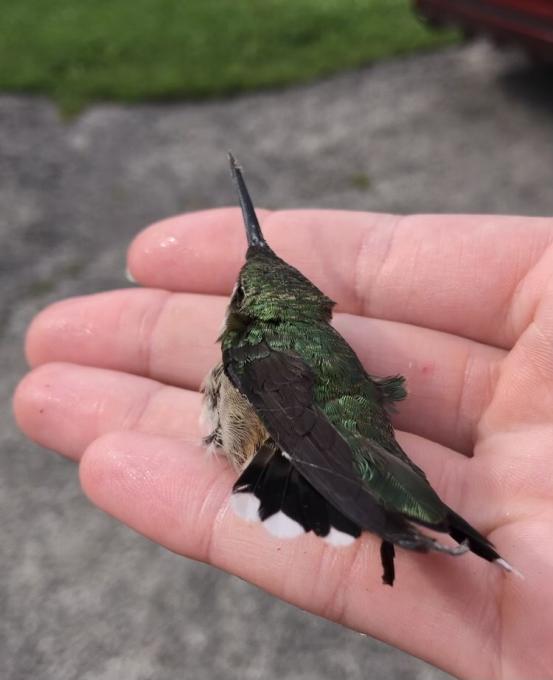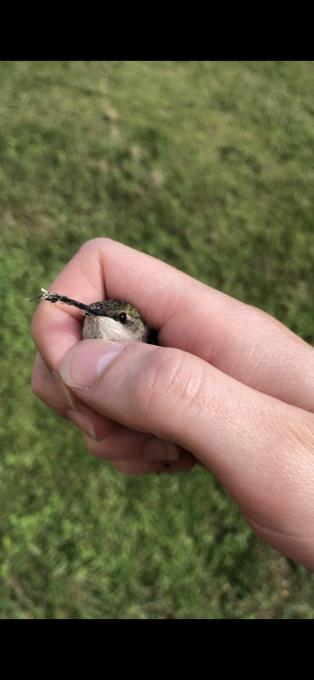Alanna
Forum Replies Created
Viewing 15 posts - 1 through 15 (of 15 total)
-
AlannaParticipantI have seen hummingbirds in real life several times now having 3 hummingbird feeders. For what I am from, I only see them May-September which are the Ruby Throated Hummingbirds which are in the genetic species of the bee hummingbirds that I learned in this course. Last year, I saved a hummingbird that was caught in the webs on the window at my house. I rushed over and helped the little guy to get the webs off her feet, face, and bill. She couldn’t help herself getting stuck there since hummingbirds like to use webs to use for nesting material and the bugs collected in them for food. Plus there was a lot of red color by the window. I always wanted to hold a hummingbird and it was such an exciting opportunity for me to actually help and hold one. In the end the hummingbird was perfectly ok and continued feeding off my feeders.


 in reply to: What Makes a Hummingbird a Hummingbird #974721
in reply to: What Makes a Hummingbird a Hummingbird #974721 -
AlannaParticipantI have hummingbird feeders out and other bird feeders out. I will have the American Goldfinch as an example of another bird. I noticed that both species can get a little territorial with their food as both species are out there to survive and produce. The obvious difference is the food intake. Hummingbirds like to have mostly nectar since that is 90% of their diet and only 10% of it is insects. The American Goldfinch for example eats neither of those and they are granivores that eat mostly seeds from trees and annual plants.in reply to: Life of a Hummingbird #974711
-
AlannaParticipantI knew that hummingbirds are one of the smallest bird species in the world and how they love to eat nectar and at night they go through torpor. There is a quite bit of things I learned in this course but I’ll give out a couple. Not only is the wing autonomy of the hummingbirds different than other birds that I knew already, but the leg autonomy. Other birds are able to walk but when it comes to the hummingbirds, they can only perch and rest 75% of the day which I thought hummingbirds seem to only rest mostly in the night. The most fascinating I learned about hummingbirds is how their feather structure is like all over their bodies and gorget. Their feathers are flat like flat disks that are piled on top of one another that can go up to 12 layers depending on what genetic species of hummingbirds. The melanosomes are the key to have the light absorb or reflect off the feathers that we love and fascinate to this day. Absolutely amazing knowing the science behind that.in reply to: How Hummingbirds Rule the Nectar World #974705
-
AlannaParticipantI really enjoyed this course. I love the fact I know more information about owls especially learning how to find them since I always wanted to find myself an owl. This course made me more aware of the owls around me. I’ll keep an eye out if I see any pellets, white wash, and have my window open at night if I ever hear a hoot. This course also motivates me to get myself a nest box for owls in my back yard.in reply to: Find the Hidden Owl #850537
-
AlannaParticipantI have seen an owl in real life. It was getting dark and I saw a huge bird that look like it had ear tufts that was sitting on top of a pine tree that was in my backyard. Right away I noticed it was the Great Horned Owl was so fascinating to see since I never seem them unless I hear them at night. I was on school trip for college and we went to a park that kept wildlife that were injured and being taken care of. I noticed they had raptor birds and an Owl that was the Barred Owl.in reply to: Who Is That Owl? #843886
-
AlannaParticipantThe crows near me do not seem to get into any fights for marking their territories and they look perfectly healthy and happy. I never seen a crow with a missing foot unless I never notice since crows adapt and live on with their lives as if they have two feet. Along aggression I would see is a bunch of crowing but even that doesn't seem to be anything serious. Next time that I see crows, I want to look even more closely if they have any missing feet and if they are starting to mark territories.in reply to: A Real Murder of Crows #838761
-
AlannaParticipant2. When I see a large group of birds come by its always an exciting thing to see. The most I have seen a group of crows is a total of 10. I can imagine how cool it will be to see a huge roost of crows landing in my yard and sleeping on top of the trees at night. I would not want to disturb them even though I would want to intervene and be surrounding by them and take pictures and photographs.
-
AlannaParticipant1. Last Summer at times I would see 5 crows in my yard high up in the trees and I live near farmland and open prairies. I know now that it is a family and one of them would keep watch at times as the other crows were forging on the ground finding food. That is also the time too that the young have left the nest and are with their parents.in reply to: Life in a Flock #838342
-
AlannaParticipantActivity 1: Birds matter so much to me on how every single one of them are unique in their own ways by the sounds they make, the colors and patterns they show, and the behavior they bring out to the world. I never seem to get bored of them since they always give me such a joy and a passion that never seems to get old. This course has gave me more knowledge on the basics of bird watching especially knowing what types of birds I would see in different habitats and locations and this course gave me more of an awareness on how to help and save these birds.in reply to: Activities: Helping Birds in Your World #837654
-
AlannaParticipantActivity 2: Looking at the list of birds in the location of Down House and Sevenoaks, I did recognize the differences with the two when it came to the habitat and bird species. For Down House I noticed that the birds living there are mostly songbirds, Pigeons and Doves, woodpeckers and Raptors. What stood out to me the most of a bird is Rose-ringed Parakeet that is considered a parrot. They orignate in Africa and South Asia and was brought over to Europe and Japan and they now live and breed in those areas. The habitats are mix of Forest and Open. Sevenoaks is more towards Aquatic Habitat seeing Waterfowl, wading birds, and shorebirds.in reply to: Activities: Exploring Bird Habitats #835184
-
AlannaParticipantActivity 2: I have noticed that the Black-capped Chickadee tends to go to my feeders not for a long time. The bird will either grab a seed and fly away or the bird will stay where it is at at the feeder and open the seed up by putting the sunflower seed between its feet and hammering it open. The House Sparrows tend to stay for a bit I would say less than 5 minutes depending on how much seed and how hungry. These birds would peck at the seeds or on the ground and (Activity 2:) they tend to look up as they eat and now I know they look up to see by checking their surroundings if there are predator coming by or near. I noticed too that birds at my feeders would get very territorial for example I saw a Male House Sparrow scaring off the female House Sparrows away from the food and the American Goldfinches tend to do the same with each other by fighting over the food. A few months back I had Common Blackbirds start to take over my feeders and the smaller birds like that sparrow and finches did not want to go near them until they were either gone or would get the leftover seeds that were pushed off the feeders. I saw it as predators were by and they did not want to go near them.in reply to: Activities: Noticing Behaviors #835048
-
AlannaParticipantActivity 2: The three birds that live around in my area all year around are the American Goldfinch, the Cedar Waxwing, and the Mallard. The other three birds however that only stay in my area for a bit and migrate are the Dark-eyed junco, the Chipping Sparrow, and the Rose-breasted Grosbeak. The birds I listed that stay all year around I would see them quite often at my bird feeders or hiking and would see the ducks mostly Mallards at a pond or a lake. The birds that pass through are the Dark-eyed junco and at the time I did not know what they were are until I started looking through my bird identification books. The Chipping Sparrow was a bird I never saw before in the area. I read how they would come by here in the summer time for breeding and would go South. The Rose-breasted Grosbeak I saw in the begging of May going to my feeders. These birds migrate late in the spring and early in the fall.in reply to: Activities: Different Seasons, Different Birds #834877
-
AlannaParticipantActivity 3: Searching on the Merlin app, easily I found 5 birds in my location that I did not know they were there. The Red-headed Woodpecker that could be spotted easily it seems like for the way his head is fully red. And this bird stays in my region all year around according to the map. This type of woodpecker is unlikely like the other woodpeckers how the bird has solid colors instead of having patterns. Listening to the sounds, I did recognize some of them by the way the bird would hammer its head on the tree trunk. An Indigo Bunting would breed here in the summer. This striking blue bodied bird which is a male I have never seen and would love to find. The only Blue Bird I have seen in my location is the Blue Jay. The Indigo Bunting would breed in shrubby areas and edges of the forests and fields. The females are plains brown with a whiteish throat, blueish tail, and have faint streaks in the underparts. I could of possible see a female without knowing it was an Indigo Bunting and thinking it was either some type of sparrow or finch. And again I have heard of their sound before. There is a rare bird breeding in my location that is called the Scarlet Tanager. The males are a bright red during their breeding season and could be easily spotted with such color. Both female and male would be the same color of yellow-olive when the male is not in breeding season. Their song is described as a American Robin with a sore throat. A water bird called the Hooded Merganser would be in areas such as wooded swamps, ponds, and rivers. Looking at the picture of the bird I would not expect on seeing them since they look like the types of bird that would be in the tropical areas the way they have puffy heads and the colors of brown, white, and black. During the winter they would be in calm bodies of water but they will never be in the ocean. Their sound kind of reminds me of a crow. A bird that has red eyes and is hard to see its eyes in person is the Red-eyed Vireo. They are a plain olive green with whiteish below with no wing bars. Would breed in mature deciduous forests and would actually sing all day long. They would flock with Chickadees and Warblers during their migration routes.in reply to: Activities: Local Bird Exploration #834680
-
AlannaParticipantActivity 1: There are two birds that I can tell apart by their shape that is the Song Sparrow and Black-capped Chickadee. They come to my window feeder quite often. The Black-capped Chickadee has a big head and a plump body with a short and stubby bill. The Song sparrow is a bit larger than the Black-capped Chickadee but has a smaller head and has more of a rounded tail. The bird has streaks down its body. Activity 3: The Song Sparrow would peck at its food instead of hammering like the Black-capped Chickadee would do to open the sunflower seeds. The Mourning Dove would peck at the seeds laying all over the ground from the feeder up above them. The doves would also look up at times too.in reply to: Activities: Bird ID Practice #834574
-
AlannaParticipantActivity 2: The bird groups that I have around me are the songbirds like the House Sparrows and American Robins where many times I would see sparrows come up to my feeders and the Robins exploring in the suburbs. I would see raptors in the sky while I am driving around such as the Red Tailed Hawk and also Turkey Vultures. Once in awhile I would see a Bald Eagle sitting up high in the tree. And the third bird group I see are the Doves, specifically Mourning Doves. Many times a pair of Mourning Doves would hangout and sit by my feeders from access seeds that fall onto the ground and the doves at dawn would be on top of my roof making their vocal sounds.in reply to: Activities: Exploring Birds #834253
Viewing 15 posts - 1 through 15 (of 15 total)


